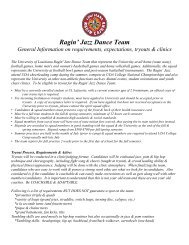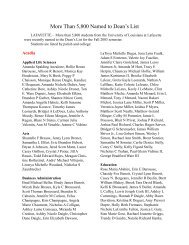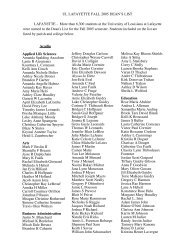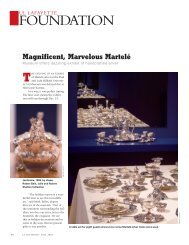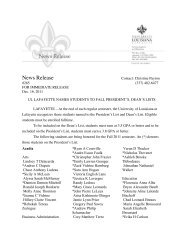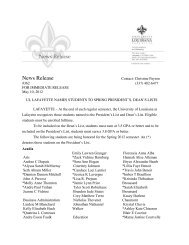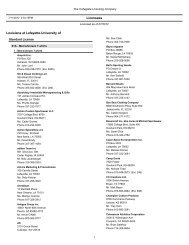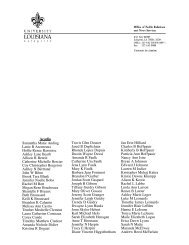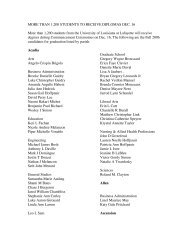here - University of Louisiana at Lafayette
here - University of Louisiana at Lafayette
here - University of Louisiana at Lafayette
Create successful ePaper yourself
Turn your PDF publications into a flip-book with our unique Google optimized e-Paper software.
Policies and Guidelines<br />
Regarding Classroom<br />
Behavior<br />
Student Life & Conduct<br />
Martin Hall, Room 223<br />
Phone: 337.482.6373<br />
Email: studentlife.conduct@louisiana.edu<br />
1
Students and faculty have shared<br />
responsibility for maintaining an<br />
appropri<strong>at</strong>e learning environment<br />
2
Faculty have the pr<strong>of</strong>essional responsibility to<br />
tre<strong>at</strong> students with understanding, dignity and<br />
respect. Students are expected to demonstr<strong>at</strong>e<br />
appropri<strong>at</strong>e, respectful behavior toward other<br />
members <strong>of</strong> the university community, both<br />
faculty and peers. Disruptive students in the<br />
academic setting hinder the educ<strong>at</strong>ional process.<br />
Disruptive student conduct is prohibited by the<br />
Code <strong>of</strong> Student Conduct & Appeal Procedures,<br />
which also enumer<strong>at</strong>es the formal actions th<strong>at</strong><br />
may be taken in such cases.<br />
3
Wh<strong>at</strong> constitutes a<br />
disruption?<br />
4
“Disruption,” as applied to the academic setting,<br />
means behavior th<strong>at</strong> a reasonable faculty member<br />
would view as interfering with normal academic<br />
functions.<br />
Examples include, but are not limited to:<br />
•Persistently speaking without being recognized<br />
•Interrupting other speakers<br />
•Behavior th<strong>at</strong> distracts the class from the subject<br />
m<strong>at</strong>ter or discussion<br />
•In extreme cases, physical thre<strong>at</strong>s, harassing<br />
behavior or personal insults<br />
•Refusal to comply with faculty direction<br />
5
Prevention<br />
6
The best time to deal with disruption is before it begins. Faculty can<br />
take steps to reduce the likelihood <strong>of</strong> disruptive behaviors in the<br />
classroom.<br />
•Explicitly st<strong>at</strong>e expect<strong>at</strong>ions for conduct in the syllabus. Include<br />
specifics, such as “turn <strong>of</strong>f pagers and cell phones before entering the<br />
classroom.”<br />
•Explain consequences for inappropri<strong>at</strong>e behavior.<br />
•Review these expect<strong>at</strong>ions with students during the first class<br />
meeting<br />
•Model respectful communic<strong>at</strong>ion with your students<br />
•Facilit<strong>at</strong>e respectful exchange <strong>of</strong> ideas among your students.<br />
•Respond to problems consistently and in a timely manner<br />
7
Handling classroom<br />
disruptions<br />
8
In cases <strong>of</strong> IMMEDIATE<br />
THREAT to you or others,<br />
immedi<strong>at</strong>ely call <strong>University</strong><br />
Police <strong>at</strong><br />
337-482-6447.<br />
Otherwise….<br />
9
1. Have a priv<strong>at</strong>e convers<strong>at</strong>ion with the student to<br />
discuss the disruptions you are observing and<br />
possible remedies for the situ<strong>at</strong>ion.<br />
2. The faculty member may want to follow up with a<br />
written summary to the student, re-st<strong>at</strong>ing your<br />
expect<strong>at</strong>ions and consequences for continued<br />
disruption. You may copy the Dean <strong>of</strong> Students<br />
and /or the Department <strong>of</strong> Student Life & Conduct.<br />
(Step 2 is not recommended in all cases.)<br />
10
3. Students who fail to respond to your <strong>at</strong>tempts to<br />
rectify their disruption should be referred to the<br />
Department <strong>of</strong> Student Life & Conduct. Depending<br />
on the n<strong>at</strong>ure and level <strong>of</strong> disruption, either<br />
<strong>University</strong> Police or a Student Life & Conduct Dean<br />
may have to remove the student from the<br />
classroom. Upon notifying the Department <strong>of</strong><br />
Student Life & Conduct, the Dean will <strong>at</strong>tempt to<br />
make contact with the student before the next class.<br />
4. Consulting your Department Head or College Dean<br />
may be helpful in developing a plan for dealing with<br />
a disruptive student.<br />
11
5. Formal disciplinary action may include: Disciplinary<br />
reprimand, prob<strong>at</strong>ion, suspension or dismissal from<br />
the <strong>University</strong>. Permanent removal from class must<br />
comply with the judicial process. It is advisable not to<br />
inform a student th<strong>at</strong> he/she is permanently<br />
dismissed until the full procedure to effect such<br />
action has been completed.<br />
12
6. Keep records <strong>of</strong> the difficulties, and your efforts to<br />
resolve them, including all written communic<strong>at</strong>ion.<br />
These will be helpful in the case <strong>of</strong> formal actions. It<br />
is recommended th<strong>at</strong> copies <strong>of</strong> your notes be sent to<br />
Department <strong>of</strong> Student Life & Conduct or Dean <strong>of</strong><br />
Students Office.<br />
13
Faculty are educ<strong>at</strong>ors and academicians. Being<br />
forced into another role -such as counselor or<br />
disciplinarian- because <strong>of</strong> a student situ<strong>at</strong>ion can be<br />
uncomfortable, and/or awkward. In such situ<strong>at</strong>ions,<br />
consider consulting with campus resources th<strong>at</strong> may<br />
be helpful in resolving issues with the student.<br />
A range <strong>of</strong> support and inform<strong>at</strong>ional services are<br />
available to faculty and to students: Dean <strong>of</strong><br />
Students Office, Department <strong>of</strong> Student Life &<br />
Conduct, Counseling & Testing Center, <strong>University</strong><br />
Police, and Office <strong>of</strong> Disability Services.<br />
14
**Although some disruptive students may have<br />
emotional or mental disorders and thus are disabled<br />
and protected under the Rehabilit<strong>at</strong>ion Act (ADA),<br />
they are held to the same standards <strong>of</strong> conduct as all<br />
other students.**<br />
15
ACADEMIC DISHONESTY<br />
16
17<br />
Buggey, T. (2007, Summer). Storyboard for Ivan's morning routine. Diagram. Journal <strong>of</strong><br />
Positive Behavior Interventions, 9(3), 151.
DEFINITIONS OF CHEATING AND PLAGIARISM<br />
1) Che<strong>at</strong>ing, in the context <strong>of</strong> academic m<strong>at</strong>ters, is<br />
the term broadly used to describe all acts <strong>of</strong><br />
dishonesty committed in the taking <strong>of</strong> tests or<br />
examin<strong>at</strong>ions and in the prepar<strong>at</strong>ion <strong>of</strong><br />
assignments. Che<strong>at</strong>ing includes but is not<br />
limited to such practices as gaining help from<br />
another person, using crib notes, relying on a<br />
calcul<strong>at</strong>or or any current technology if such<br />
aids have been forbidden. Preparing an<br />
assignment in consult<strong>at</strong>ion with another<br />
person when the instructor expects the work to<br />
be done independently is also considered<br />
che<strong>at</strong>ing. In other words, che<strong>at</strong>ing occurs<br />
when a student makes use <strong>of</strong> any unauthorized<br />
aids or m<strong>at</strong>erials. Furthermore, any student<br />
who provides unauthorized assistance in<br />
academic work is also guilty <strong>of</strong> che<strong>at</strong>ing.<br />
18
Plagiarism<br />
Plagiarism is a specific type <strong>of</strong> che<strong>at</strong>ing.<br />
It occurs when a student passes <strong>of</strong>f as<br />
their own the ideas or words <strong>of</strong> another<br />
person, when a student presents as a<br />
new and original idea or product<br />
anything which in fact is derived from an<br />
existing work, or when a student makes<br />
use <strong>of</strong> any work or production already<br />
cre<strong>at</strong>ed by someone else without giving<br />
credit to the source.<br />
In short, plagiarism is the use <strong>of</strong><br />
unacknowledged m<strong>at</strong>erials in the<br />
prepar<strong>at</strong>ion <strong>of</strong> assignments. Thus, the<br />
student must take care to avoid<br />
plagiarism by research or term papers,<br />
art projects, architectural designs,<br />
musical compositions, science reports,<br />
labor<strong>at</strong>ory experiments, and the like.<br />
19
How to Handle Che<strong>at</strong>ing and<br />
Plagiarism<br />
Those <strong>of</strong> us in the pr<strong>of</strong>ession <strong>of</strong> educ<strong>at</strong>ion agree th<strong>at</strong><br />
che<strong>at</strong>ing/plagiarism incidents are not always easy to<br />
handle. It is sometimes challenging to those who<br />
report such incidents, to those who have to confront<br />
the students and to those who are responsible for<br />
making the final decisions in concluding the case. Yet<br />
we know th<strong>at</strong> che<strong>at</strong>ing/plagiarism presents an unfair<br />
standard, is wrong and must be addressed.<br />
20
Academic Dishonesty Cases<br />
120<br />
100<br />
80<br />
60<br />
40<br />
20<br />
0<br />
52<br />
74<br />
45<br />
72<br />
52<br />
67<br />
81 89<br />
102<br />
2003 2005 2007 2009 2011<br />
82<br />
(Jan- October 16, 2012)<br />
Source: Student Life & Conduct<br />
StarRez D<strong>at</strong>abase<br />
Cases<br />
21
Faculty member would proceed<br />
accordingly.<br />
1) The student(s) should be talked to in priv<strong>at</strong>e and confronted<br />
with the charge.<br />
2) The faculty member should allow the student to admit or deny<br />
the charge.<br />
3) The faculty member may choose <strong>at</strong> th<strong>at</strong> time to indic<strong>at</strong>e to the<br />
student his/her belief <strong>of</strong> the charge or decide to indic<strong>at</strong>e to the<br />
student th<strong>at</strong> a final decision will be made and th<strong>at</strong> the student<br />
will be notified either by the faculty member or by the<br />
Department Student Life & Conduct.<br />
*Faculty may proceed with step 1 or choose to go directly to step 5<br />
22
4) The faculty member would <strong>at</strong> this time complete the<br />
Academic Dishonesty Report and forward to the Department<br />
<strong>of</strong> Student Life & Conduct. If the Department <strong>of</strong> Student Life<br />
& Conduct discovers th<strong>at</strong> this student has a history <strong>of</strong><br />
che<strong>at</strong>ing, the faculty member will be contacted and a final<br />
decision will be made regarding the appropri<strong>at</strong>e discipline in<br />
this case.<br />
5) The faculty member may chose to refer the inform<strong>at</strong>ion to the<br />
Department <strong>of</strong> Student Life & Conduct to handle the entire case. The<br />
faculty member would complete the Academic Dishonesty Report and<br />
forward to the Department <strong>of</strong> Student Life & Conduct. The faculty<br />
member will be contacted by the Department <strong>of</strong> Student Life &<br />
Conduct if it is discovered th<strong>at</strong> the student is a repe<strong>at</strong> <strong>of</strong>fender <strong>of</strong><br />
che<strong>at</strong>ing/plagiarism.<br />
23
Faculty member chooses to handle in<br />
conjunction with the Department <strong>of</strong><br />
Student Life & Conduct.<br />
� If you choose this route, our <strong>of</strong>fice will assist you in<br />
any manner you choose.<br />
� We will either advise or assist you in assessing<br />
sanctions.<br />
� We could charge the student with a viol<strong>at</strong>ion <strong>of</strong> the<br />
Code <strong>of</strong> Student Conduct.<br />
� In extreme cases w<strong>here</strong> che<strong>at</strong>ing warrants dismissal,<br />
our <strong>of</strong>fice would charge the student to appear<br />
before the Student Discipline Committee and<br />
request dismissal/suspension from the <strong>University</strong><br />
24
We are concerned th<strong>at</strong> academic<br />
dishonesty is not being reported.<br />
1) Che<strong>at</strong>ing handled within the department<br />
� If you receive a report <strong>of</strong> a student che<strong>at</strong>ing or<br />
plagiarizing, you have the authority as a faculty<br />
member to investig<strong>at</strong>e and/or collect any<br />
evidence and give an appropri<strong>at</strong>e penalty.<br />
� If you c<strong>at</strong>ch a student who has either che<strong>at</strong>ed or<br />
plagiarized, the faculty may assign a "zero" for the<br />
assignment/test in question or assign an F in the<br />
course.<br />
25
� A faculty member may choose another option: under<br />
other on the form. Other can be something less than<br />
“zero” or “F” or more than, or in addition to.<br />
� We request th<strong>at</strong> whenever you sanction a student for<br />
che<strong>at</strong>ing or plagiarism, you notify our <strong>of</strong>fice via the<br />
Academic Dishonesty Report (so th<strong>at</strong> we may keep<br />
records in the event the student ever che<strong>at</strong>s again<br />
during his tenure <strong>at</strong> the <strong>University</strong>.)<br />
26
Academic Dishonesty Report form for<br />
Faculty/Staff<br />
Username: employee<br />
Password: paperwork<br />
28
When using webpage:<br />
Forward one copy to<br />
Student Life and Conduct<br />
Give one copy to student<br />
Keep one copy for your records.<br />
29
Tips to be proactive about<br />
Academic Dishonesty<br />
� St<strong>at</strong>e policies and penalties on syllabus<br />
� Communic<strong>at</strong>e to your students wh<strong>at</strong> you expect and how<br />
you will handle academic dishonesty the first class session.<br />
� Make arrangements to prevent che<strong>at</strong>ing (i.e. test se<strong>at</strong>ing,<br />
moving around the room, making eye contact with students<br />
who look up, etc.)<br />
� Require students to submit their papers electronically.<br />
Archive the papers and reference them in future classes if<br />
you suspect another student has submitted the same paper.<br />
� If you suspect plagiarism, use a free full-text search engine<br />
like www.google.com or www.find-same.com<br />
30
Resources:<br />
� Online Che<strong>at</strong>ing A New Twist to an Old Problem<br />
� http://owl.english.purdue.edu/owl/<br />
� http://www.plagiarism.org/<br />
� http://ullafayettestudenthandbook.com/code-<strong>of</strong>student-conduct-and-appeal-procedures<br />
31
<strong>University</strong> Ombudsman<br />
Ms. Lena M. Bethell<br />
Coronna Hall Rm. 216<br />
(337) 482-6947<br />
Email: ombudsman@louisiana.edu<br />
The <strong>University</strong> Ombudsman is responsible for<br />
informing students <strong>of</strong> their rights in the process <strong>of</strong><br />
grade and disciplinary appeals. The Ombudsman is<br />
available to all students in need <strong>of</strong> advice.<br />
32
Contact Inform<strong>at</strong>ion<br />
P<strong>at</strong>ricia F. Cottonham<br />
Dean <strong>of</strong> Students<br />
Martin Hall, Room 211<br />
Phone: 337.482.6272<br />
Email: p<strong>at</strong>cottonham@louisiana.edu<br />
Gregory G. Zerangue<br />
Student Life & Conduct<br />
Martin Hall, Room 223<br />
Phone: 337.482.6373<br />
Email: studentlife.conduct@louisiana.edu<br />
33



